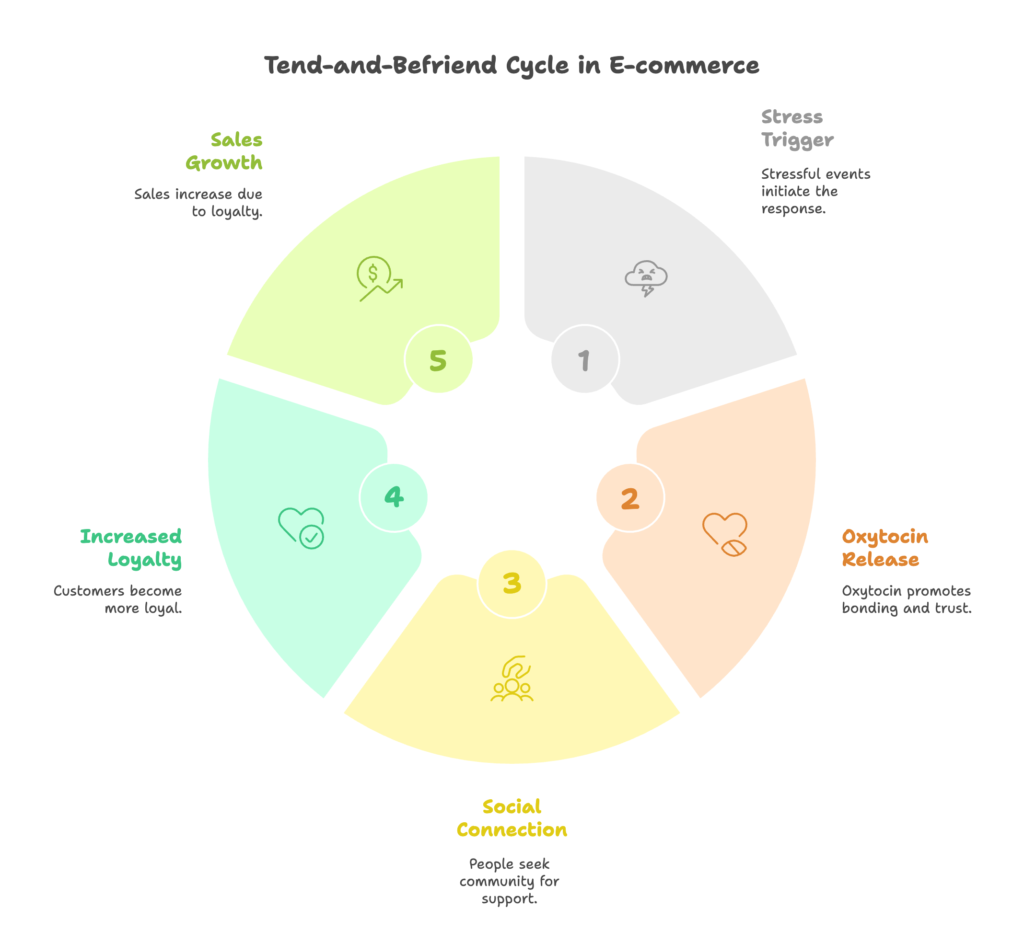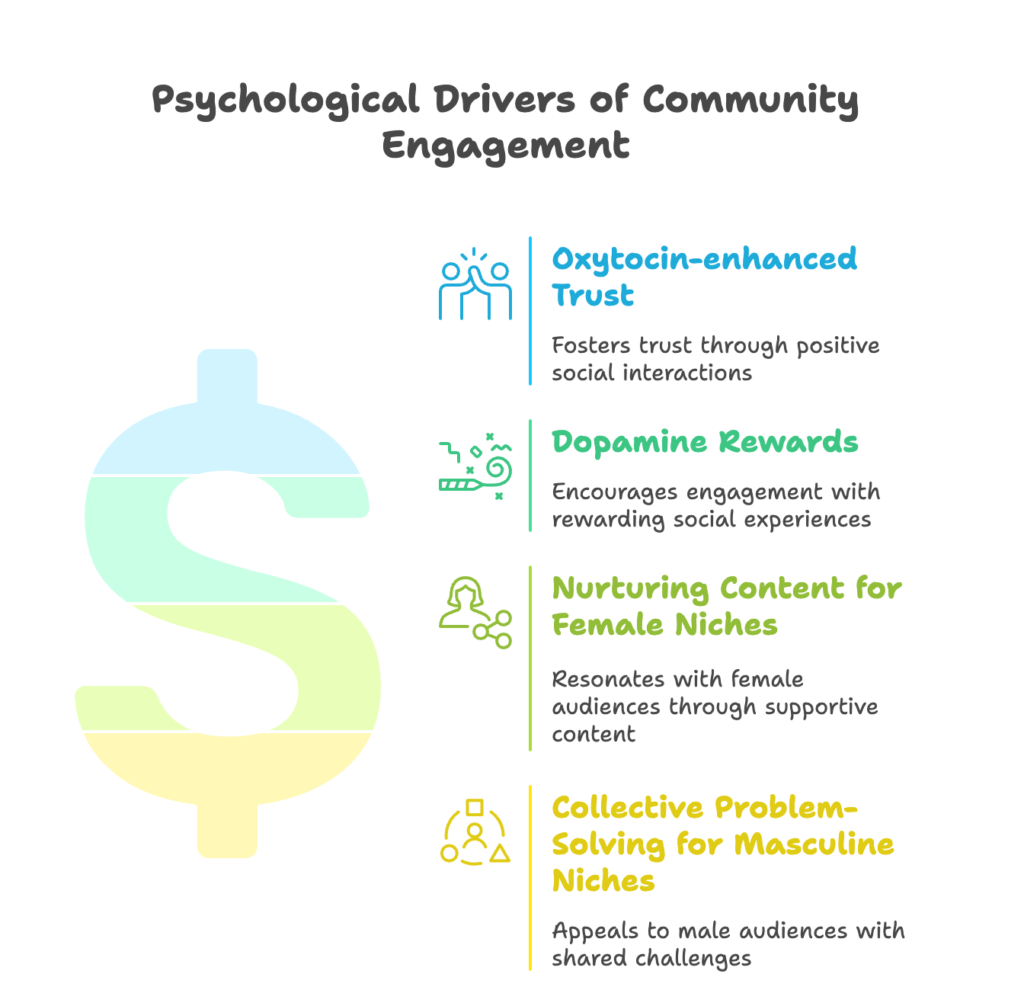I. Introduction to Tend-and-Befriend in E-commerce
We all know the classic stress response: fight or flight. When things get tough, instinct tells us to either confront the threat or run for the hills. But what if there’s another way? Scientists have identified a different, equally powerful response, especially prevalent when we feel connected to others: tend and befriend. This isn’t just fascinating biology; it’s a potential goldmine for your Shopify store.

A. Defining the Biological Response to Stress
So, what exactly is “tend and befriend”? At its core, it’s our innate drive to protect offspring (tending) and seek out social groups for mutual defense and support (befriending) during stressful times. Think about it: when faced with uncertainty or crisis, people naturally draw closer to loved ones and communities.
1. Neuroscience of social bonding: This response is fueled by neurochemicals, particularly oxytocin. Often called the “love hormone,” oxytocin release is triggered by stress (counterintuitively!) alongside social interaction. It promotes feelings of trust, empathy, and bonding, essentially calming the fight-or-flight reaction and encouraging connection instead.
2. Contrast with fight-or-flight: While fight-or-flight focuses on individual survival, tend-and-befriend leverages the power of the group. In e-commerce, this difference is stark. Stores fostering strong communities see significantly better results. For instance, research suggests community-focused stores boast 58% higher customer retention compared to those solely focused on transactions. That’s the power of connection in action.
B. Relevance for Shopify Merchants
This isn’t just academic theory; it’s directly applicable to your Shopify business, especially when navigating turbulent waters like economic downturns, market shifts, or global crises.
1. Consumer Priorities Shift: During challenging times, consumer needs evolve. It’s not just about the product anymore. Data shows that 73% of consumers actively prioritize brands that offer social connection and community support during crises. They’re looking for brands that care, listen, and foster a sense of belonging.
2. Tangible Business Impact: Building community isn’t just a feel-good strategy; it drives real results. Consider the brands that leaned into community building during the COVID-19 pandemic. Case studies revealed they experienced an average 41% sales lift compared to those who didn’t. Why? Because they provided support, connection, and a shared space when customers needed it most.
Understanding tend-and-befriend gives you a powerful framework for building resilience, loyalty, and growth, even when times are tough. Now, let’s explore the psychological drivers making this so effective.
II. Psychological Foundations for Community Building
Why does fostering community resonate so deeply with customers, especially online? The answer lies in our brain chemistry and psychological needs. Understanding these drivers helps you craft more effective community strategies for your Shopify store.

A. Neurochemical Drivers of Social Commerce
Our brains are wired for connection, and specific chemicals reward us for social interaction, even in a commercial context.
1. Oxytocin-enhanced trust: As mentioned, oxytocin is key. When your brand facilitates positive social interactions – think helpful forums, group chats, or shared customer stories – it can trigger oxytocin release. This fosters trust not just between members, but also towards your brand itself. Customers feel safer and more connected, making them more likely to engage and purchase within your branded community.
2. Dopamine rewards: Social commerce taps into our brain’s reward system. Dopamine, often associated with pleasure and motivation, is released during positive social experiences. Collaborative shopping experiences, like group buying, voting on new products, or achieving shared goals within a loyalty program, can provide these dopamine hits. This makes participating in your community feel rewarding and encourages repeat engagement.
B. Gender-Specific Implementation
While tend-and-befriend is a universal human response, research suggests nuances in how different genders might engage with community initiatives. Tailoring your approach can maximize its impact.
1. Nurturing Content for Female-Dominated Niches: Studies indicate that nurturing, supportive content resonates strongly in niches typically dominated by female consumers. In fact, data suggests 68% of female-dominated Shopify niches benefit significantly from content emphasizing care, empathy, and shared experiences. Think blog posts about overcoming challenges, supportive forums, or highlighting customer stories of mutual support.
2. Collective Problem-Solving for Masculine Appeal: For niches often attracting a predominantly male audience, framing community around collective problem-solving or shared challenges can be highly effective. Strategies like creating forums dedicated to troubleshooting product issues, sharing expert tips, or facilitating group discussions around achieving specific goals (e.g., fitness targets, project completion) tap into a desire for competence and camaraderie.
By understanding these psychological underpinnings, you can design community initiatives that genuinely resonate with your target audience. Next, let’s dive into concrete strategies you can implement directly within Shopify.
III. Shopify-Specific Community Building Strategies
Knowing the ‘why’ behind community is great, but *how* do you actually build it on Shopify? Thankfully, the platform and its ecosystem offer powerful tools. Let’s break down both crisis-responsive tactics and long-term community architecture.
A. Crisis-Responsive Tactics
When unexpected challenges arise, a strong community can be your biggest asset. Here’s how to leverage Shopify tools for immediate support:
1. Real-time support systems:
- a. LiveChat integration for group troubleshooting: Integrate apps like Tidio or Gorgias not just for one-on-one support, but consider creating temporary “group help” channels during product launches or widespread issues. Customers can often help each other, reducing support load and fostering camaraderie.
- b. Shopify Inbox AI for mass personalized check-ins: Use Shopify Inbox, potentially enhanced with AI capabilities, to send out proactive, personalized check-in messages during a crisis. Ask how customers are doing, offer relevant support, or share community resources. Even automated messages can show you care on a larger scale.
2. Collaborative product development:
- a. Voting systems via Growave UGC tools: Apps like Growave allow you to gather user-generated content (UGC) and run polls or voting contests. During uncertain times, involve your community in decisions. Ask them what products they need most right now, vote on upcoming designs, or crowdsource ideas for supportive content. This makes them feel heard and invested.
B. Always-On Community Architecture
Beyond immediate crises, embedding community into your store’s fabric builds long-term loyalty and resilience.
1. Social Login Optimization:
- a. Faster sign-ups via Facebook/Google integration: Make joining your community effortless. Enabling social login options (like Facebook or Google) through Shopify’s settings or dedicated apps can lead to significantly faster sign-ups – potentially 37% quicker. Lowering friction increases participation.
- b. Behavioral tracking for personalized onboarding: Once users sign up (with consent, of course!), use behavioral data tracked within Shopify or via integrated apps to personalize their community onboarding experience. Guide them towards relevant discussions, content, or groups based on their purchase history or Browse behavior.
2. Tiered Loyalty Ecosystems:
- a. Smile.io configurations for mutual member rewards: Loyalty apps like Smile.io aren’t just for points. Configure them to reward community engagement. Offer points for forum posts, reward members for helping others, or create referral bonuses that benefit both the referrer and the new member. Focus on mutual benefit.
- b. VIP groups with exclusive co-creation opportunities: Create exclusive tiers or groups within your loyalty program (or via dedicated community platforms). Offer top members early access, exclusive content, or even opportunities to co-create products with your brand. This fosters deep loyalty and turns customers into advocates.
These strategies, powered by Shopify’s tools, transform your store from a simple marketplace into a thriving hub. Now, let’s look at the specific touchpoints where you can implement these ideas.
IV. Implementing Tend-and-Befriend Touchpoints
Building a community requires consistent effort across various customer touchpoints. It’s about weaving connection into the fabric of the customer journey using engaging content and smart platform configurations.
A. Content Strategies
Your content is a primary vehicle for fostering connection and demonstrating the “tend and befriend” ethos.
1. Stress-relief storytelling: Authenticity resonates, especially during difficult times. Share stories that humanize your brand and connect with customer experiences.
- a. Behind-the-scenes crisis management blogs: Be transparent about challenges your brand faces and how you’re navigating them. Sharing your own vulnerability builds trust and relatability. For example, detail supply chain hurdles and how your team is working together to overcome them.
- b. User-generated hardship testimonials: Encourage (and sensitively curate) stories from your customers about how they’ve used your products or found support within the community during tough times. Platforms like Growave or Yotpo can help collect and showcase these powerful narratives.
2. Interactive Elements: Passive content consumption isn’t community. Encourage active participation.
- a. Gamified survival guides using Klaviyo SMS: Use marketing automation tools like Klaviyo creatively. Develop a fun, informative “survival guide” related to your niche (e.g., “WFH Survival Guide,” “New Parent Survival Guide”) delivered via SMS or email, incorporating quizzes, challenges, or points systems to drive engagement.
- b. AR-powered group unboxing experiences: Leverage Shopify’s AR capabilities. Imagine customers being able to trigger an AR experience upon receiving their package, perhaps sharing a virtual “unboxing” moment with others in the community forum or via a dedicated app feature.
B. Platform Configurations
Use Shopify’s native features and app integrations to create dedicated community spaces and automate supportive interactions.
1. Community Builder app workflows: Apps specifically designed for community building (like Discourse, Circle, or dedicated Shopify apps found on app stores like Helpscout guides) offer robust features.
- a. Post-purchase Slack/Discord invites: Configure automated workflows to invite customers to a private community space (like Slack or Discord) immediately after purchase. This captures their excitement and channels it into a community setting.
- b. Moderation protocols for safe spaces: Essential for any community. Establish clear guidelines and use moderation tools (often built into community platforms) to ensure discussions remain respectful, supportive, and safe for all members.
2. Shopify Flow automations: Leverage Shopify’s powerful automation tool, Flow (available on Shopify Plus or via apps for other plans).
- a. Trigger support groups based on cart abandonment: If a customer abandons a cart containing specific “stress-related” products (e.g., wellness items, baby care), trigger a Flow automation to send a supportive email, perhaps inviting them to a relevant community discussion or offering help.
- b. Emergency resource distribution systems: During widespread crises (natural disasters, health emergencies), use Flow to identify affected customers (based on shipping address) and automate the distribution of helpful information, links to resources, or even special discount codes for essential items.
By thoughtfully implementing these content and platform strategies, you create multiple avenues for customers to connect, support each other, and feel cared for by your brand. But how do you know if it’s working?
V. Measuring Community Impact
Building a community feels good, but how do you measure its actual impact on your business and customer well-being? While directly measuring oxytocin levels isn’t feasible for most stores, you can track valuable proxies and tangible business outcomes.
A. Neurological Metrics (Proxies)
We can’t hook customers up to brain scanners, but we can analyze their behavior and sentiment online to infer engagement and emotional response – proxies for the neurological effects of community.
1. Hotjar attention heatmaps for group content: Use tools like Hotjar to analyze how users interact with your community pages, forums, or blog posts featuring user stories. Heatmaps showing where users click, scroll, and spend time can indicate which pieces of community-focused content are truly capturing attention and engagement – a sign they resonate emotionally.
2. GA4 emotion cluster analysis: Dive into Google Analytics 4 (GA4). While it doesn’t directly measure emotion, you can analyze user flows, engagement rates with specific community features, and potentially segment users based on their participation levels. Combine this with sentiment analysis of forum posts or reviews (using NLP tools if available) to build clusters representing engaged, supportive community members versus passive browsers.
B. Business Outcomes
Ultimately, community efforts need to translate into measurable business results. Track these key performance indicators (KPIs):
1. Higher Customer Lifetime Value (CLTV): Community fosters loyalty. Track the CLTV of customers who actively participate in your community versus those who don’t. Data often shows a significant uplift – potentially a 19% higher CLTV for community participants, as they tend to buy more often and stay longer.
2. Reduction in Crisis-Period Returns: A supportive community can often resolve issues before they lead to returns. Peer-to-peer support in forums can answer questions, troubleshoot problems, and manage expectations, especially during stressful periods like shipping delays. Stores leveraging peer support have seen return rates drop significantly, sometimes by as much as 62% during crisis periods, as customers find solutions within the community.
By tracking both engagement proxies and concrete business metrics, you can demonstrate the ROI of your tend-and-befriend strategy and continuously refine your approach. However, implementation requires care and ethical consideration.
VI. Ethical Implementation Framework
Leveraging the “tend and befriend” response is powerful, but it comes with responsibility. Building community, especially during vulnerable times, requires a strong ethical framework to ensure you’re genuinely supporting customers, not exploiting their needs.
A. Privacy-Preserving Bonding
Connection shouldn’t come at the cost of privacy. Ensure your community initiatives respect user data and autonomy.
1. GDPR-compliant behavioral tracking: If you’re tracking user behavior to personalize community experiences (as discussed in Section III), ensure your methods are fully compliant with privacy regulations like GDPR, CCPA, etc. Be transparent about data collection and provide clear opt-out mechanisms. Use data to enhance support, not just for targeted selling.
2. Anonymous support channel options: Recognize that not everyone feels comfortable sharing personal struggles publicly. Offer anonymous ways to seek support within the community, perhaps through designated channels, private messaging with moderators, or forms that don’t require revealing identity. Tools like Shopify Inbox might offer features to facilitate this discreetly.
B. Crisis Capitalism Avoidance
It’s crucial to ensure your community efforts are perceived as authentic support, not opportunistic marketing during a crisis.
1. Authenticity checks for community initiatives: Before launching any crisis-response community initiative, ask yourself: Is this genuinely helpful? Does it align with our brand values? Avoid initiatives that feel purely promotional or tone-deaf to the situation. Focus on providing real value, support, or resources.
2. Trauma-informed moderation training: If your community discusses sensitive topics or supports users through hardship, your moderators need proper training. Implement trauma-informed practices, teaching moderators to respond with empathy, avoid triggering language, de-escalate conflict sensitively, and know when to guide users towards professional resources. This ensures the community remains a safe and genuinely supportive space.
Building community ethically means prioritizing customer well-being, respecting privacy, and acting with genuine empathy. This approach not only avoids pitfalls but also strengthens the trust that underpins the entire tend-and-befriend dynamic. What does the future hold for this approach?
VII. Future of Stress-Responsive Commerce
The principle of “tend and befriend” in commerce is timeless, but the tools and technologies enabling it are constantly evolving. Looking ahead, AI and immersive experiences promise to scale community building and deepen connections in exciting ways.
A. AI-Powered Community Scaling
Artificial intelligence offers opportunities to manage and enhance online communities more effectively and personally, even at scale.
1. ChatGPT-4 mediated peer support: Imagine AI assistants (like versions of ChatGPT-4) integrated into community forums. They could help moderate discussions, answer common questions instantly, summarize long threads, or even facilitate peer-to-peer support by identifying users who might have relevant experience to help others, freeing up human moderators for more complex issues.
2. Predictive needs analysis via ShopifyQL: Using Shopify’s powerful query language, ShopifyQL (available on Plus plans), combined with machine learning, stores could potentially analyze purchasing patterns, Browse behavior, and community interactions to *predict* emerging customer needs or stress points. This allows brands to proactively offer support, relevant content, or community resources *before* customers even explicitly ask.
B. Immersive Technologies
As technology advances, digital interactions can become more engaging and emotionally resonant, bridging the gap between online and real-world connection.
1. VR town halls using Shopify AR: Imagine hosting virtual “town hall” meetings or Q&A sessions with your brand’s leadership or experts within a VR environment. Shopify’s growing AR capabilities could pave the way for more immersive group experiences, making community members feel more present and connected than a standard video call allows.
2. Haptic feedback for digital group hugs: While still futuristic, advancements in haptic technology (touch feedback) could eventually be integrated into social platforms or even e-commerce experiences. Imagine devices allowing users to send or receive subtle tactile feedback – a virtual “pat on the back” or “group hug” – adding another layer of emotional connection to digital support within your community.
While some of these technologies are still emerging, the core principle remains: leveraging technology not just for transactions, but to foster genuine human connection and support, is the future of resilient and successful e-commerce. Applying the “tend and befriend” framework today builds the foundation for thriving in that future.
References
- Taylor, S.E. et al. (2000). Tend and Befriend: Biobehavioral Bases. https://taylorlab.psych.ucla.edu/wp-content/uploads/sites/5/2014/11/2011_Tend-and-Befriend-Theory.pdf
- Shopify. (2025). Community Building Best Practices. https://www.shopify.com/blog/building-community
- Baymard Institute. (2024). Social Proof Optimization. https://baymard.com/research/trust-signals
- Helpscout. (2025). Shopify Community Apps Guide. https://www.helpscout.com/blog/shopify-customer-service-apps/
- Levy, J. (2020). COVID-19 Community Case Studies. https://www.shopify.com/enterprise/blog/brands-building-community-during-covid-19
Ready to supercharge your Shopify store’s sales with perfectly optimized discount codes? Growth Suite is a Shopify app that helps you do just that, boosting revenue by ensuring customers use the right codes at the right time. Install it with a single click and start seeing results!




